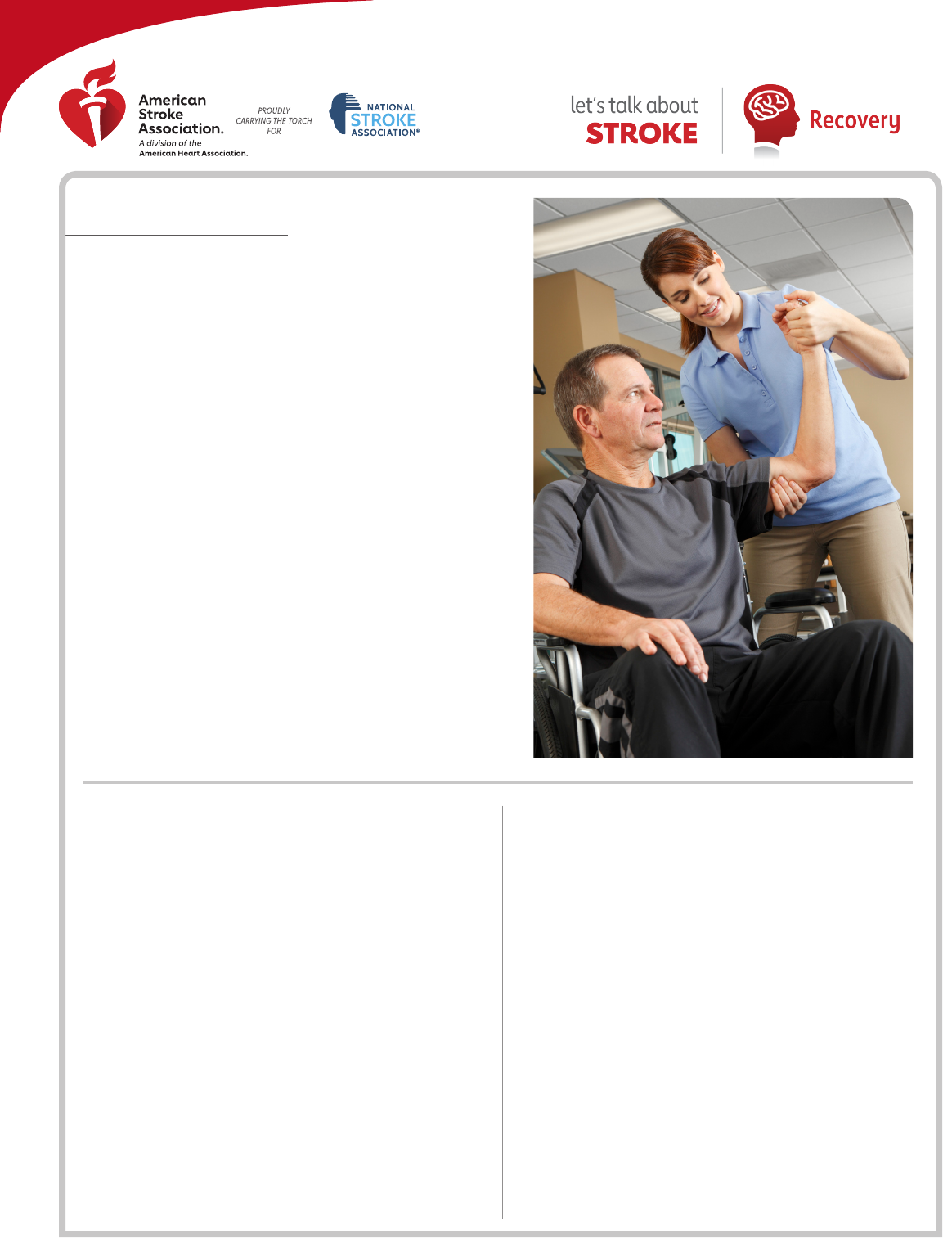
let’s talk about
Spasticity After
Stroke
After a stroke, muscles may become stiff, tighten
up and resist stretching. This is called spasticity.
Spasticity relates to muscle tone. Tone is the
natural tension, or contraction, in a muscle that
resists stretching. Stroke may cause an abnormal
increase in muscle tone, leading to spasticity. Muscle
contractions become more intense. The contractions
may involve one muscle or a group of muscles. For
some, spasticity may be mild muscle stiffness, for
others it may be severe, resulting in pain or spasms.
Spasticity may also lead to xed joints (contracture).
When muscle tone is abnormally tight, it causes
muscles to shrink and shorten. Joints can become
stuck in one position and quite hard to move. For
example, this may cause a wrist to curl in or an arm
to stay in a folded position up against the chest.
What causes spasticity and how common it is?
A stroke is a brain injury. When the injured area of the brain
controls muscle tone, spasticity may occur. About 25 to 43% of
survivors will have spasticity in the rst year after their stroke.
It’s more common in younger stroke survivors. It’s also more
common when the stroke is caused by a bleed (hemorrhagic).
The timing of spasticity occurring after a stroke can vary. It
may start soon after having the stroke or more than a year
later.
What are the effects of spasticity?
Effects of spasticity include:
• Stiff ngers, arms or legs
• Muscles contract and relax on their own
• Contracture that may cause pain or discomfort
• Muscle tiredness
• Muscle and joint deformity over time
Examples:
• A clenched st
• Tensed ngers
• A bent arm held against the chest
• Tightness in the knees
• Involuntary crossing (scissoring) of the legs
• A foot that’s bent at an angle
• A weakened foot that drags, making it hard to walk
(also known as foot drop)
• Curled toes, making it hard to walk (also known as claw
toe)
Everyday tasks may become much harder when an arm
or hand is affected. Simply grasping and using objects,
reaching overhead or taking care of personal hygiene can
be a challenge. Walking becomes much harder when the
legs or feet are affected. The risk of falling increases.
(continued)

Spasticity After Stroke
How is spasticity treated?
• Moving as much as possible is important to ease muscle
tightening and prevent muscle shortening. Regular
stretching with a wide range of motion is helpful. Regular
exercise of the affected limbs is benecial.
• Braces or splints may help to hold a muscle in place and
stop it from contracting.
• Shots of botulinum toxin into spastic muscles in the upper
and lower limbs can bring relief. There may be some
soreness in the area of the injections.
• There are oral medications that can help. However, side
effects, such as weakness, sleepiness or nausea may
occur when taking oral medications.
• ITB (intrathecal baclofen) therapy involves implanting
a small pump. The pump delivers medication (baclofen)
directly into the spine. The medicine travels via the spinal
uid. This helps prevent side effects that may happen
with oral medication. ITB may be considered when a
patient doesn’t respond well to other treatments.
Your health care provider will prescribe the best treatment
approach for you based on how severe your spasticity is.
A combination of physical therapy and medication can be
quite effective.
HOW CAN I LEARN MORE?
Call 1-888-4-STROKE (1-888-478-7653)
to learn more about stroke or nd
local support groups, or visit
strokeassociation.org.
Sign up to get Stroke Connection
magazine, a free magazine for
stroke survivors and caregivers, at
strokeconnection.org.
Connect with others sharing similar
journeys with stroke by joining
our Support Network at
strokeassociation.org/supportnetwork.
Do you have
questions for the
doctor or nurse?
Take a few minutes to
write your questions
for the next time you
see your health care
provider.
For example:
What are the best
stretching exercises to
keep my muscles from
tightening?
We have many other fact sheets to help you make healthier choices to reduce your risk, manage
disease or care for a loved one. Visit strokeassociation.org/letstalkaboutstroke to learn more.
© Copyright 2019 American Heart Association, Inc., a 501(c)(3) not-for-prot. All rights reserved.
American Stroke Association is a registered trademark of the AHA. Unauthorized use prohibited.
MY QUESTIONS:
